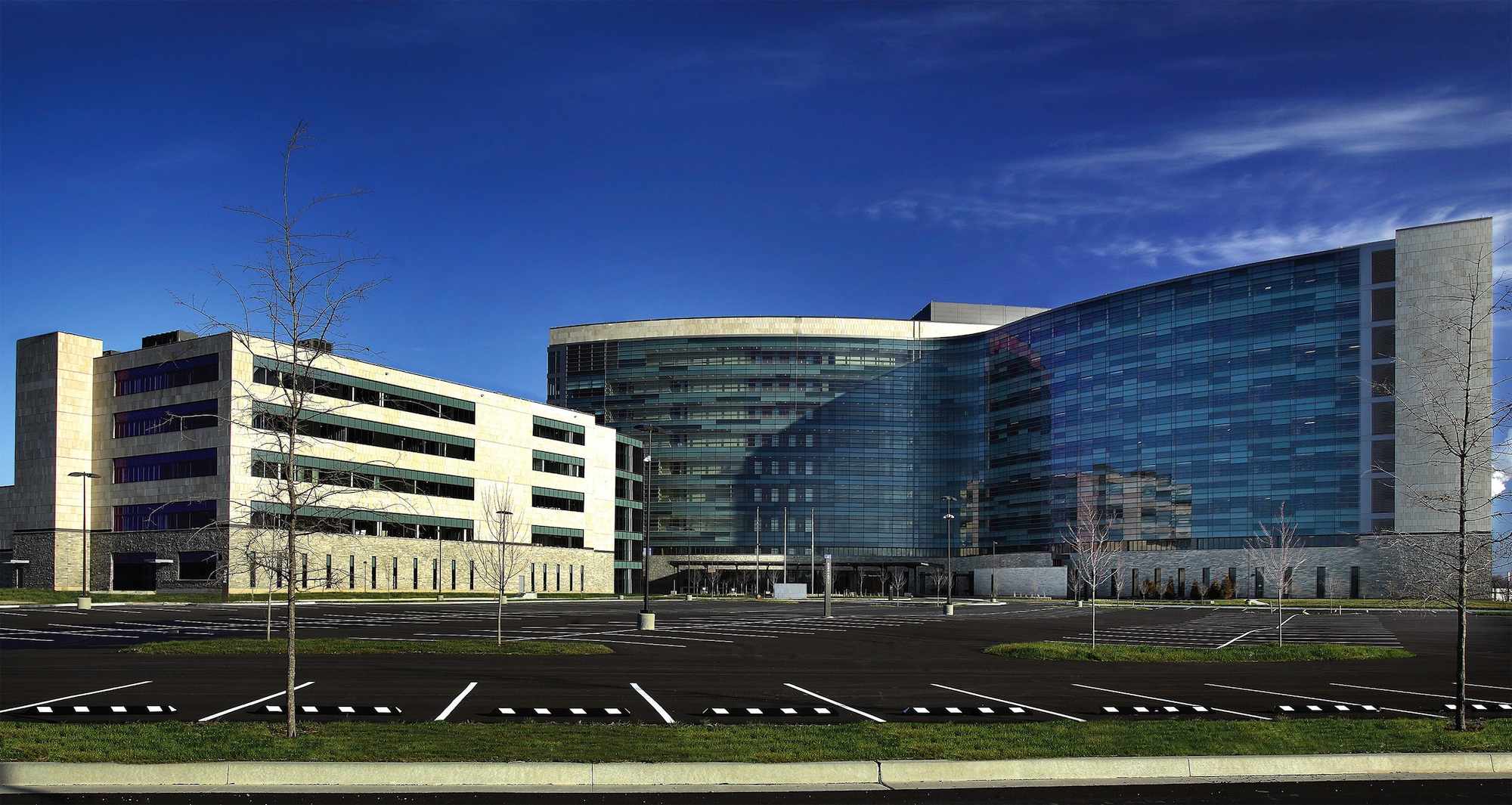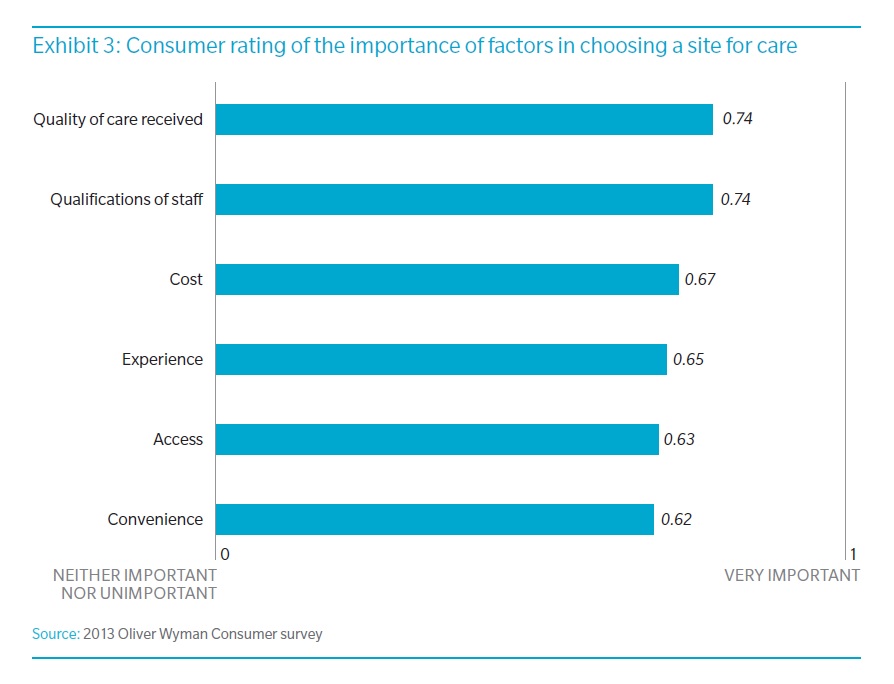By mid-year 2014 approximately $2.3 billion of venture funding for digital health had been placed, surpassing the total investment made in all of 2013. This is yet another statistic that demonstrates an evolving healthcare ecosystem where reform is creating disruptive forces that alter the impact and importance of the players involved.
With changing business practices and a greater emphasis on consumerism, healthcare organizations are looking across their enterprises for answers. Facilities are not escaping the drag net and we continue to see evolving trends that will define the market for real estate and facilities services in 2015 and beyond. The three areas of change we will explore are new products, delivery models, and relationships.
NEW PRODUCTS
With consumers funding more and more of their healthcare services out of pocket, they are becoming more selective in who they seek healthcare services from. In a 2013 survey of healthcare consumers conducted by Oliver Wyman, consumers responded that their top reason for choosing a particular healthcare services location was the quality of care received. Consumers will be focused on every interaction they have with a healthcare provider to rate quality of care from setting up their appointments to the results they experience during and after their visit. The concept of “service” will become a focus of providers that will be successful in 2015 and beyond.
As healthcare organizations plan new facilities and evaluate their overall real estate portfolio, they will continue to look towards facilities that support a first class experience. Not only will they be concerned with the consumer experience, but employee satisfaction will also play a major role. The continued growth of retail care in a healthcare organizations real estate portfolio will continue to be a focus in 2015 and beyond. We will likely see more unique mixed-use projects that carry the live, work and play theme as healthcare focuses on prevention rather than episodic care.
DELIVERY MODELS
As healthcare organizations change their business practices across the enterprise, they are also looking to change the way facilities are delivered and managed. Integrated project delivery models are being requested on a more frequent basis. Many companies that used to market to healthcare organizations as design-build firms have altered their messaging to include the term “integrated.” Healthcare organizations continue to adopt performance improvement models such as Lean to improve their business and integrated project delivery is a natural fit for that culture.
The shift towards an integrated model of delivery is not just project by project based but portfolio based as well.
Healthcare organizations are beginning to see the value of reviewing their entire portfolio and determining the highest and best use for each asset with an understanding of the role it can play in a highly distributed service model. This has increased the demand for strategic real estate planning services that are more holistic than we have seen in the past.
There is a growing desire to develop key performance indicators (KPIs) that take into account clinical outcomes, service line financial performance, building performance and space utilization among other points. Analytical models will be developed in the future that provide an accepted rating system and allow healthcare organizations to measure the true performance of their real estate assets across the ecosystem.
RELATIONSHIPS
New products and an emphasis on new delivery models create new relationships. As healthcare organizations seek more opportunities to save in the delivery and care of facilities, they continue to demand more from group purchasing organizations (GPOs). In the past, GPOs have been focused on medical equipment and other essential supplies necessary to deliver care.
As healthcare organizations expand their net for savings opportunities, they are requesting volume pricing on construction materials, building systems and service contracts. With a limited amount of GPO coverage within this sector, healthcare organizations are exploring direct relationships with key suppliers in an effort to drive prices and increase schedule efficiencies by having more direct control over supply chains.
With an emphasis on ambulatory and retail building products, speed to market becomes more important and, therefore, better predictability with respect to schedule and budget. This has created a demand for roll-out strategies that can deliver portfolios rather than single projects. Healthcare organizations are seeking qualified integrated teams to deliver a solution including the ability to finance, design, build and maintain.
The relationship model continues to shift to a group of preferred providers that are in tune with the organization’s overall strategy and understand their culture and decision making style. In an industry with plenty of chaos, seeking solutions that provide a more predictable outcome will be a focus for healthcare organizations in 2015 and beyond.
CONCLUSION
Healthcare continues to shift toward Madison Avenue and Silicon Valley as it revamps business practices to focus on consumerism and efficiency. Not only does this impact the actual delivery of services, but it continues to have a large effect on the location and type of facility in which those services are delivered. In the next year, expect to see the following:
• Product. A continued emphasis on Ambulatory and Retail facilities and increased development of population health management tools such as wellness centers, adult daycare centers, and virtual medicine hubs.
• Delivery. Continued alignment in the delivery and care of facilities with a culture of improvement. An increase in integrated project delivery and risk sharing models based on short and long term outcomes. Development of holistic analytical models for evaluating portfolio performance.
• Relationships. A change in the relationship between Suppliers, GPOs and healthcare organizations that provides more direct access to innovations without delays and surcharges.
For service providers in the real estate, design and construction industry it will be important to understand how exactly how the healthcare industry is evolving. With shifting payment models and an emphasis on value creation, healthcare organizations will be open to partners that are able to contribute to achieving their strategic goals and not just deliver on a transaction.
The more a firm can demonstrate a predictable outcome that delivers results, the quicker they will become a trusted and preferred partner well into the future.
Related Stories
Affordable Housing | Apr 1, 2024
Biden Administration considers ways to influence local housing regulations
The Biden Administration is considering how to spur more affordable housing construction with strategies to influence reform of local housing regulations.
Affordable Housing | Apr 1, 2024
Chicago voters nix ‘mansion tax’ to fund efforts to reduce homelessness
Chicago voters in March rejected a proposed “mansion tax” that would have funded efforts to reduce homelessness in the city.
Standards | Apr 1, 2024
New technical bulletin covers window opening control devices
A new technical bulletin clarifies the definition of a window opening control device (WOCD) to promote greater understanding of the role of WOCDs and provide an understanding of a WOCD’s function.
Adaptive Reuse | Mar 30, 2024
Hotel vs. office: Different challenges in commercial to residential conversions
In the midst of a national housing shortage, developers are examining the viability of commercial to residential conversions as a solution to both problems.
Sustainability | Mar 29, 2024
Demystifying carbon offsets vs direct reductions
Chris Forney, Principal, Brightworks Sustainability, and Rob Atkinson, Senior Project Manager, IA Interior Architects, share the misconceptions about carbon offsets and identify opportunities for realizing a carbon-neutral building portfolio.
Reconstruction & Renovation | Mar 28, 2024
Longwood Gardens reimagines its horticulture experience with 17-acre conservatory
Longwood Gardens announced this week that Longwood Reimagined: A New Garden Experience, the most ambitious revitalization in a century of America’s greatest center for horticultural display, will open to the public on November 22, 2024.
Office Buildings | Mar 27, 2024
A new Singapore office campus inaugurates the Jurong Innovation District, a business park located in a tropical rainforest
Surbana Jurong, an urban, infrastructure and managed services consulting firm, recently opened its new headquarters in Singapore. Surbana Jurong Campus inaugurates the Jurong Innovation District, a business park set in a tropical rainforest.
Cultural Facilities | Mar 27, 2024
Kansas City’s new Sobela Ocean Aquarium home to nearly 8,000 animals in 34 habitats
Kansas City’s new Sobela Ocean Aquarium is a world-class facility home to nearly 8,000 animals in 34 habitats ranging from small tanks to a giant 400,000-gallon shark tank.
Market Data | Mar 26, 2024
Architecture firm billings see modest easing in February
Architecture firm billings continued to decline in February, with an AIA/Deltek Architecture Billings Index (ABI) score of 49.5 for the month. However, February’s score marks the most modest easing in billings since July 2023 and suggests that the recent slowdown may be receding.
Cultural Facilities | Mar 26, 2024
Renovation restores century-old Brooklyn Paramount Theater to its original use
The renovation of the iconic Brooklyn Paramount Theater restored the building to its original purpose as a movie theater and music performance venue. Long Island University had acquired the venue in the 1960s and repurposed it as the school’s basketball court.


















